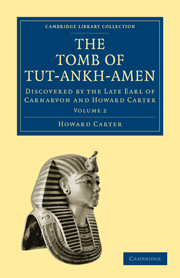Book contents
- Frontmatter
- PREFACE
- Contents
- LIST OF PLATES
- INTRODUCTION. REMARKS UPON EGYPTIAN ART
- CHAPTER 1 TUT-ANKH-AMEN
- CHAPTER 2 THE TOMB AND BURIAL CHAMBER
- CHAPTER 3 CLEARING THE BURIAL CHAMBER AND OPENING THE SARCOPHAGUS
- CHAPTER 4 THE STATE CHARIOTS
- CHAPTER 5 THE OPENING OF THE THREE COFFINS (SEASON 1925–26)
- CHAPTER 6 POINTS OF INTEREST IN EGYPTIAN BURIAL CUSTOMS
- CHAPTER 7 THE EXAMINATION OF THE ROYAL MUMMY
- APPENDICES
- APPENDIX I REPORT UPON THE EXAMINATION OF TUT-ANKH-AMEN'S MUMMY
- APPENDIX II THE CHEMISTRY OF THE TOMB
- APPENDIX III REPORT ON THE FLORAL WREATHS FOUND IN THE COFFINS OF TUT-ANKH-AMEN
- APPENDIX IV NOTES ON OBJECTS FROM THE TOMB
- APPENDIX V REPORT ON THE EXAMINATION OF SPECIMENS FROM THE TOMB OF KING TUT-ANKH-AMEN
- APPENDIX VI DESCRIPTION OF THE OBJECTS. PLATES XXXVII-LXXXVIII
- INDEX
- Plate section
- Plate section
APPENDIX V - REPORT ON THE EXAMINATION OF SPECIMENS FROM THE TOMB OF KING TUT-ANKH-AMEN
Published online by Cambridge University Press: 05 March 2012
- Frontmatter
- PREFACE
- Contents
- LIST OF PLATES
- INTRODUCTION. REMARKS UPON EGYPTIAN ART
- CHAPTER 1 TUT-ANKH-AMEN
- CHAPTER 2 THE TOMB AND BURIAL CHAMBER
- CHAPTER 3 CLEARING THE BURIAL CHAMBER AND OPENING THE SARCOPHAGUS
- CHAPTER 4 THE STATE CHARIOTS
- CHAPTER 5 THE OPENING OF THE THREE COFFINS (SEASON 1925–26)
- CHAPTER 6 POINTS OF INTEREST IN EGYPTIAN BURIAL CUSTOMS
- CHAPTER 7 THE EXAMINATION OF THE ROYAL MUMMY
- APPENDICES
- APPENDIX I REPORT UPON THE EXAMINATION OF TUT-ANKH-AMEN'S MUMMY
- APPENDIX II THE CHEMISTRY OF THE TOMB
- APPENDIX III REPORT ON THE FLORAL WREATHS FOUND IN THE COFFINS OF TUT-ANKH-AMEN
- APPENDIX IV NOTES ON OBJECTS FROM THE TOMB
- APPENDIX V REPORT ON THE EXAMINATION OF SPECIMENS FROM THE TOMB OF KING TUT-ANKH-AMEN
- APPENDIX VI DESCRIPTION OF THE OBJECTS. PLATES XXXVII-LXXXVIII
- INDEX
- Plate section
- Plate section
Summary
(1) Reed Torch (from Floor Rubbish of Burial Chamber). The pith is impregnated with a black gum-resin which has probably been poured into the reed in the molten condition. It is readily soluble in alcohol and largely soluble also in ether. The small insoluble portion on extraction with water yields a trace of gum. The acid value for the original product is 137.9. The gummiferous portion is slightly dextrorotatory in aqueous solution. Microscopic examination of the residue insoluble in alcohol, revealed the pitted vessels characteristic of coniferous woods, and the solutions had a decided odour of pine.
The experimental evidence suggests that this specimen is a pine resin of some kind, possibly from juniper.
(2) Red Resin (from Kiosks, Plate LIII,B). This was red and very powdery. About 93.9 per cent. was soluble in alcohol and 6.1 per cent, soluble in water. It gave a terebenthinate smell on being heated. Its acid value was 137.7. It was practically insoluble in benzene and in ether. The qualitative evidence from solubilities suggests shellac, but for this the acid value is much too high. It is possibly Angola copal.
(3) Material from mending of Sarcophagus. This on examination proved to be a mixture of gumresin with calcium carbonate and sand. The yellow colour is due, apparently, to superficial darkening.
(4) A Fragment of Cement from the Tomb. This was found to consist of calcium sulphate with a small quantity of limestone grit and sand.
- Type
- Chapter
- Information
- The Tomb of Tut-Ankh-AmenDiscovered by the Late Earl of Carnarvon and Howard Carter, pp. 214 - 216Publisher: Cambridge University PressPrint publication year: 2010First published in: 1927



